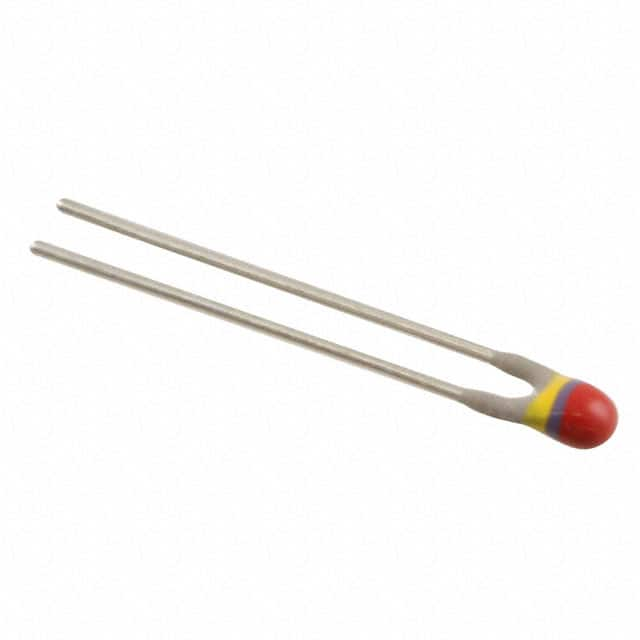NTCLE100E3472GB0
Product Overview
Category
The NTCLE100E3472GB0 belongs to the category of thermistors, specifically a type of negative temperature coefficient (NTC) thermistor.
Use
It is commonly used for temperature sensing and control applications in various electronic devices and systems.
Characteristics
- Temperature Sensing: The NTCLE100E3472GB0 exhibits a change in resistance with temperature, making it suitable for temperature measurement.
- Stability: It offers stable and reliable performance over a wide temperature range.
- Accuracy: Provides accurate temperature readings for precise control and monitoring.
Package
The NTCLE100E3472GB0 is typically available in a small, compact package suitable for surface mounting on PCBs.
Essence
The essence of NTCLE100E3472GB0 lies in its ability to accurately sense and respond to changes in temperature, making it an essential component in temperature control systems.
Packaging/Quantity
It is commonly supplied in reels or trays, with quantities varying based on manufacturer specifications.
Specifications
- Resistance at 25°C: 4.7 kΩ
- Tolerance: ±1%
- Operating Temperature Range: -40°C to 125°C
- Maximum Power Rating: 150 mW
- Thermal Time Constant: 10 s
Detailed Pin Configuration
The NTCLE100E3472GB0 typically features two pins for connection, with the pinout configuration as follows: 1. Pin 1: Connection point for one end of the thermistor 2. Pin 2: Connection point for the other end of the thermistor
Functional Features
- Temperature Sensing: Accurately measures temperature changes through its resistance variation.
- Compact Size: Small form factor enables integration into space-constrained designs.
- Wide Operating Range: Suitable for diverse temperature measurement applications.
Advantages and Disadvantages
Advantages
- Precise temperature measurement
- Compact size for easy integration
- Wide operating temperature range
Disadvantages
- Non-linear response at extreme temperatures
- Sensitivity to self-heating effects in high-power applications
Working Principles
The NTCLE100E3472GB0 operates based on the principle of negative temperature coefficient, where its resistance decreases as the temperature increases. This characteristic allows it to accurately sense and respond to temperature changes within the specified range.
Detailed Application Field Plans
The NTCLE100E3472GB0 finds extensive use in various applications, including: - Temperature Control Systems: Used in HVAC systems, industrial ovens, and consumer appliances for temperature regulation. - Battery Management: Employed in battery charging circuits to monitor and control charging temperatures. - Automotive Electronics: Integrated into automotive climate control systems and engine management for temperature sensing.
Detailed and Complete Alternative Models
- NTCLE100E3103JB0: Similar NTC thermistor with a different resistance value
- NTCLE100E3223JB0: Alternative model with a slightly lower resistance at 25°C
- NTCLE100E3333JB0: Comparable NTC thermistor with a different resistance rating
In conclusion, the NTCLE100E3472GB0 thermistor offers precise temperature sensing capabilities, making it a vital component in various electronic systems and devices. Its compact size, wide operating range, and accuracy make it well-suited for temperature control and monitoring applications across diverse industries.
Word Count: 486
Senaraikan 10 soalan dan jawapan biasa yang berkaitan dengan aplikasi NTCLE100E3472GB0 dalam penyelesaian teknikal
What is the NTCLE100E3472GB0 used for?
- The NTCLE100E3472GB0 is a thermistor commonly used for temperature sensing and control in various technical solutions.
What is the temperature range of the NTCLE100E3472GB0?
- The NTCLE100E3472GB0 has a temperature range of -40°C to 125°C, making it suitable for a wide range of applications.
How does the NTCLE100E3472GB0 work?
- The NTCLE100E3472GB0 operates based on the principle of resistance change with temperature, providing a reliable indication of the ambient temperature.
What are the typical applications of the NTCLE100E3472GB0?
- Typical applications include temperature monitoring and control in consumer electronics, automotive systems, industrial equipment, and HVAC systems.
What is the accuracy of the NTCLE100E3472GB0?
- The NTCLE100E3472GB0 offers high accuracy in temperature measurement, with a tolerance typically within ±1°C.
How should the NTCLE100E3472GB0 be connected in a circuit?
- The NTCLE100E3472GB0 should be connected in series with a resistor in a voltage divider configuration to measure the temperature-dependent resistance.
Can the NTCLE100E3472GB0 be used in harsh environments?
- Yes, the NTCLE100E3472GB0 is designed to withstand harsh environmental conditions and is suitable for use in rugged applications.
What are the key considerations when designing with the NTCLE100E3472GB0?
- Key considerations include proper thermal management, calibration for accurate temperature readings, and protection against moisture and contaminants.
Does the NTCLE100E3472GB0 require any special calibration?
- While the NTCLE100E3472GB0 is highly accurate, some applications may benefit from specific calibration to ensure precise temperature measurements.
Where can I find detailed technical specifications for the NTCLE100E3472GB0?
- Detailed technical specifications, including electrical characteristics and thermal response, can be found in the datasheet provided by the manufacturer.


